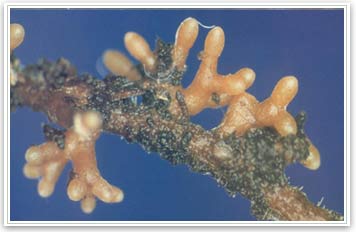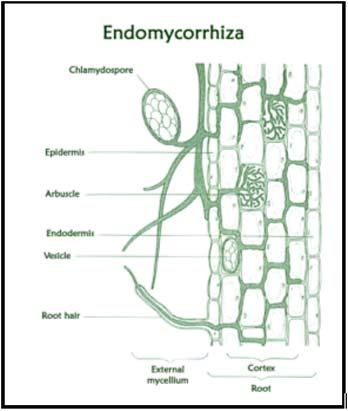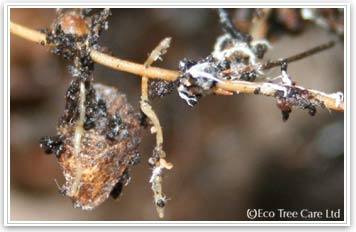Introduction
 |
| http://www.ecotreecare.co.uk/mycorrhizal-inoculation-biology.htm |
Arbuscular Mycorrhiza (AM) is the entity that forms when a plant and fungus grow or come together as one. The plant and fungus form a mutualistic relationship where the plant receives water and nutrients from the fungus, while also giving the fungus fixed carbon (food) [1] It is said that this relationship is over 400 million years old and evidence of the relationship was found in early Devonian land plants. This relationship could have helped plants become more terrestrial [3].
Description Of The Relationship
In this relationship the fungus has almost direct access to the plant's glucose, which is produced by photosynthesis. The plant then has access to the AM's large surface area, which is used to absorb extra water and inorganic minerals that are found in the soil. Another benefit for the plant is that it receives protection from disease due to the protective covering of its roots by the AM. Plants on their own have a hard time getting phosphate from the soil. The mycelium that is associated with the AM can access the phosphorus fairly easily and make it readily available [3] .
 |
| http://www.ecotreecare.co.uk/mycorrhizal-inoculation-biology.htm |
There are two types of Mycorrhizae; ectomycorrhizae and endomycorrhizae. Each one is associated with different plant species and cannot be found together. Ectomycorrhizae are mostly on the outside of the cell and do not penetrate the cell. They have hyphae that grow in between individual cells. AM are actually endomycorrhizae and most of their structure is found inside of the root. They are the most abundant and are found in 65 percent of plant families. These structures penetrate the cell and the hyphae are found inside the cell wall [3].
The fungus from the order Glomales that is associated with AM symbiosis are obligate biotrophs, asexually reproducing and forming multinucleate spores. The fungus only starts to grow when there is a presence of plant roots. Once the hyphae penetrate the root cells, tree-like structures (arbuscules) are formed in each cell. In the arbuscules is where nutrient exchange happens and is the key structure in this relationship [4].
Cost/Benefit Analysis
 |
| http://www.ecotreecare.co.uk/mycorrhizal-inoculation-biology.htm |
To maintain this relationship, plants give up about 25 percent of their photosynthetic products to the fungus. This might seem like a lot but the plant would have to spend much more energy to grow out its roots to get the same benefit it would from the fungus. In addition to getting nutrients from the relationship if the plant grew out its roots then they would be exposed to pathogens. The AM also protects the roots because of its outer covering. Overall this relationship seems to be very beneficial to the plants and also to the fungus [3].
References
1.
http://www.ncbi.nlm.nih.gov/pubmed/18794914
2.
http://www.pnas.org/content/91/25/11841.full.pdf
3.
http://www.ecotreecare.co.uk/mycorrhizal-inoculation-biology.htm
4.
http://mycorrhiza.ag.utk.edu/reviews/rev_hause1.pdf



Great write-up, I am a big believer in commenting on blogs to inform the blog writers know that they’ve added something worthwhile to the world wide web!..
ReplyDeleteMortgage
LINK1
ReplyDeleteLINK2
LINK3
LINK4
LINK5